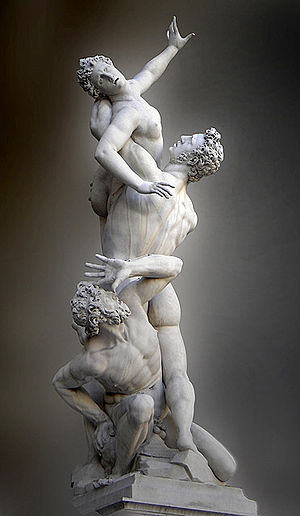
The Baroque style emerged from Renaissance sculpture, which, drawing upon classical Greek and Roman sculpture, had idealized the human form. This was modified by Mannerism, when artists strived to give their works a unique and personal style. Mannerism introduced the idea of sculptures featuring strong contrasts; youth and age, beauty and ugliness, men and women. Mannerism also introduced the figura serpentina, which became a major characteristic of Baroque sculpture. This was the arrangement of figures or groups of figures in an ascending spiral, which gave lightness and movement to the work.[6]
Michelangelo had introduced figure serpentine in The Dying Slave (1513–1516) and Genius Victorious (1520–1525), but these works were meant to be seen from a single point of view. In the late 16th century work of the Italian sculptor Giambologna, The Rape of the Sabine Women (1581–1583). introduced a new element; this work was meant to be seen not from one, but from several points of view, and changed depending upon the viewpoint, This became a very common feature in Baroque sculpture. The work of Giambologna had a strong influence on the masters of the Baroque era, particularly Bernini.[6]
Another important influence leading to the Baroque style was the Catholic Church, which was seeking artistic weapons in the battle against the rise of Protestantism. The Council of Trent (1545–1563) gave the Pope greater powers to guide artistic creation, and expressed a strong disapproval of the doctrines of humanism, which had been central to the arts during the Renaissance.[7] During the pontificate of Paul V (1605–1621) the church began to develop artistic doctrines to counter the Reformation, and commissioned new artists to carry them out.
Post time: Aug-06-2022
